Sensor Sweep: Genre Distinctions, Disney X-Men, Solomon Kane Movie
Monday , 13, May 2024 Sensor Sweep Leave a commentConan (Sprague de Camp Fan): The Conan Companion, Hall Publications, is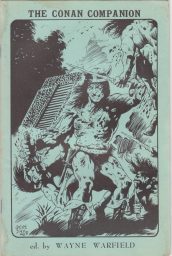 a 24-page booklet published in 1976. It consists of articles by Michael Resnick, David and Susannah Bates, John Meyer, L. Sprague de Camp, and Bill Crlikov and artwork by Gene Day, Richard L. Farley, Ken Raney, Bot Roda, and Wayne Warfield.
a 24-page booklet published in 1976. It consists of articles by Michael Resnick, David and Susannah Bates, John Meyer, L. Sprague de Camp, and Bill Crlikov and artwork by Gene Day, Richard L. Farley, Ken Raney, Bot Roda, and Wayne Warfield.
Genre (Wasteland & Sky): The reason I attached the video about the Ballantine Adult Fantasy series at the top of the post is because I believe the line is part of the source of how we got off track and into the bunk genre distinction weeds. Much of the blame goes to Disney in how wonder stories were watered down over the past century, but little is mentioned on how the framing of a book line was used to manufacture a different Year One of its own sort.
Games (Grognardia): Released in 1982, Raiders of the Lost Ark was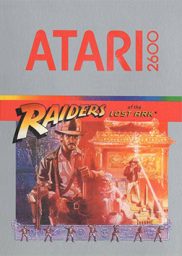 (obviously) a tie-in product for the action-adventure film of the same name released the year before. Historically, tie-in products like this tend to be mediocre at best, with most being little more than vehicles for making a quick buck by association with a popular book, TV show, or movie.
(obviously) a tie-in product for the action-adventure film of the same name released the year before. Historically, tie-in products like this tend to be mediocre at best, with most being little more than vehicles for making a quick buck by association with a popular book, TV show, or movie.
Fiction (Ken Lizzi): Originally serialized in a magazine in the last decade of the 19th century, A. Conan Doyle’s The White Company is damned near perfection. Conan Doyle is known to most as the author of the Sherlock Holmes stories. That would be enough to cement any writer’s reputation as one of the greats. But Doyle wrote prolifically and in a wide variety of genres and styles, including (among others) the Professor Challenger science fiction stories, EA Poe-esque horror stories, and historical fiction.
Streaming (Fandom Pulse): In spite of mostly positive reviews from both sides of the culture war, Disney’s X-Men 97 appears to be a complete flop in terms of viewership. For weeks now, the show hasn’t managed to break into the Nielsen Top 10 rankings, making it the worst-performing Marvel show on Disney+. In spite of the initial news that the show had managed to draw in 4 Million views for its debut episode, which was one of the most viewed premieres for a Disney+ show, the series doesn’t seem to be retaining viewers.
Pulp (Westerin Fiction Review): This collection of nine tales contains work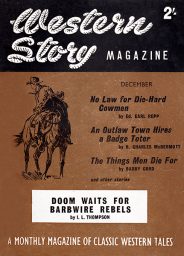 by eight authors I’d never read before, the exception being Barry Cord, so I was looking forward to trying some new writers to me. Yes, I recognized the names of a few of them but had no idea of what to expect from them when I picked up this issue of Western Story Magazine.
by eight authors I’d never read before, the exception being Barry Cord, so I was looking forward to trying some new writers to me. Yes, I recognized the names of a few of them but had no idea of what to expect from them when I picked up this issue of Western Story Magazine.
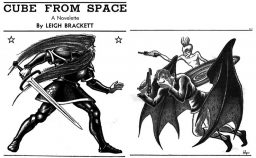
Science Fiction (Dark Worlds Quarterly): Leigh Brackett was the queen of Space. There are so many good stories to choose from but I decided on this one. “Cube From Space” (Super Science Stories, August 1942) is a corker. This is one of her Solar System stories, all set in a consistent milieu of red Martians, green Venusians and black Mercurians. I have to admit I was drawn to the image of the cube-shaped spaceship. The shape of the ship isn’t really that important but it is unusual. signers were aware of Brackett’s tale.
Fiction (Gold Medal Book Blog): John Roper is a disgraced former ship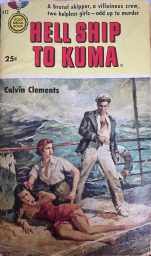 captain who is down and out in Saigon Port. He doesn’t have much money as he can’t find a skipper job that lives up to the prestige he held before getting into a jam at a corporate shipping company.
captain who is down and out in Saigon Port. He doesn’t have much money as he can’t find a skipper job that lives up to the prestige he held before getting into a jam at a corporate shipping company.
Fiction (Pulp Fiction Reviews): Chuck Dixon’s eleventh Levon Cade book picks up a few months after the climax of his last. Cade has moved his family to Idaho and bought himself a mid-size ranch where he hopes to raise horses with his daughters, Uncle Fern and tag-along vet pal, Wes.
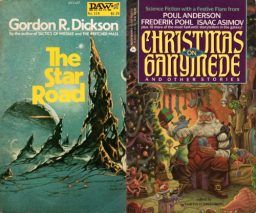 Science Fiction (M Porcius): In our last episode I condemned a story Judith Merril claimed was one of the greatest of 1962. Today we shift back in time four years to look at three stories from 1958 which Merril thought worthy of her recommendation, all three of them by Gordon R. Dickson, a writer to whom I have paid limited attention. In 2014, I read Dickson’s contribution to Five Fates and said I liked his themes of individualism and exploration but found his story ruinously slow and poorly written.
Science Fiction (M Porcius): In our last episode I condemned a story Judith Merril claimed was one of the greatest of 1962. Today we shift back in time four years to look at three stories from 1958 which Merril thought worthy of her recommendation, all three of them by Gordon R. Dickson, a writer to whom I have paid limited attention. In 2014, I read Dickson’s contribution to Five Fates and said I liked his themes of individualism and exploration but found his story ruinously slow and poorly written.
Western (Paperback Warrior): The Edge series by George Gilman (Terry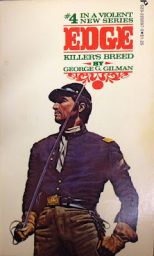 Harknett, 1936-2019) promises to be “The Most Violent Westerns in Print,” but the fourth installment, Killer’s Breed from 1974, is actually a flashback origin story documenting Edge’s adventures fighting in the American Civil War.
Harknett, 1936-2019) promises to be “The Most Violent Westerns in Print,” but the fourth installment, Killer’s Breed from 1974, is actually a flashback origin story documenting Edge’s adventures fighting in the American Civil War.
 Pop Culture (Glorious Trash): The Doors are one of those groups that go through phases in popularity. Huge in their day, then forgotten, then rediscovered due to the publication of this book, then again super famous in 1990 with Oliver Stone’s film hagiography of Jim Morrison; I still remember how the rock chicks at my high school traded out their Motley Crue shirts for Doors shirts when that movie came out.
Pop Culture (Glorious Trash): The Doors are one of those groups that go through phases in popularity. Huge in their day, then forgotten, then rediscovered due to the publication of this book, then again super famous in 1990 with Oliver Stone’s film hagiography of Jim Morrison; I still remember how the rock chicks at my high school traded out their Motley Crue shirts for Doors shirts when that movie came out.
Horror (Too Much Horror Fiction): At this time the horror mass-market paperback boom was beginning its downhill swing, although I well recall the publication of many a serious title around then: Animals by Skipp n’ Spector, Lost Souls by Poppy Z. Brite, After Age by Yvonne Navarro, Skin by Kathe Koja, as well as the continuing titles from the Dell/Abyss line. And in June came Wet Work, published by Jove Books, the first novel from young British author and journalist Philip Nutman.
Tolkien (Rip Jagger Dojo): As a learned man steeped in ancient lore, it’s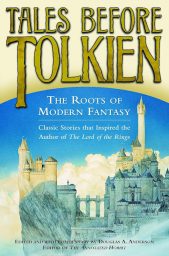 probably impossible to track down all the influences on J.R.R. Tolkien when he fashioned his stories of Middle-Earth. But editor Douglas Anderson has given it a go with the book Tales Before Tolkien -The Roots of Modern Fantasy. There are a number of delightful tales tucked away in this volume.
probably impossible to track down all the influences on J.R.R. Tolkien when he fashioned his stories of Middle-Earth. But editor Douglas Anderson has given it a go with the book Tales Before Tolkien -The Roots of Modern Fantasy. There are a number of delightful tales tucked away in this volume.
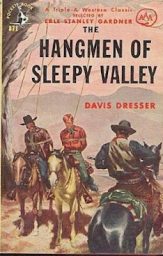 Westerns (Rough Edges): Although he was a prolific author, Davis Dresser wrote only a few books under his own name, and I believe all of them were Westerns. Best known as Brett Halliday, the creator and principal author of the Mike Shayne series, Dresser wrote quite a few Westerns as well, some under the house-name Peter Field (the Powder Valley series), some as Don Davis (the Rio Kid books, reprinted by Pocket Books in the Sixties.
Westerns (Rough Edges): Although he was a prolific author, Davis Dresser wrote only a few books under his own name, and I believe all of them were Westerns. Best known as Brett Halliday, the creator and principal author of the Mike Shayne series, Dresser wrote quite a few Westerns as well, some under the house-name Peter Field (the Powder Valley series), some as Don Davis (the Rio Kid books, reprinted by Pocket Books in the Sixties.
History (Frontier Partisans): Some of the most savage warfare in American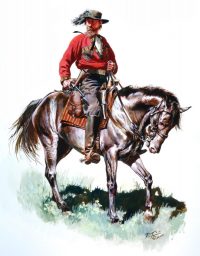 history was conducted on the border of Kansas and Missouri during the American Civil War. That region was actually a theater of low-intensity warfare before the greater conflict broke out, and it was in a very real sense a war within a war, with its own imperatives and momentum.
history was conducted on the border of Kansas and Missouri during the American Civil War. That region was actually a theater of low-intensity warfare before the greater conflict broke out, and it was in a very real sense a war within a war, with its own imperatives and momentum.
Pulp (Comics Radio): “The Crazy Kind” is set in the oil fields of Oklahoma and narrated in the style of someone casually telling the story to friends, full of humor as it moves the plot along swiftly.
RPG (Grognardia): Almost from the moment I discovered roleplaying games, I’ve primarily been a referee. To some degree, I was thrust into this role by necessity, since few of my friends were all that interested in sitting behind the screen themselves. Fortunately for them, I liked being the referee. I enjoyed making maps and creating adventure locales and thinking up new ways to challenge my players.
Cinema (Atomic Junk Shop): As far as I know, the only official stateside screening of this movie was at Comic-Con in 2009; if there was a follow-up theatrical release, we missed it. But not too long ago we acquired the DVD of Solomon Kane. Finally!
screening of this movie was at Comic-Con in 2009; if there was a follow-up theatrical release, we missed it. But not too long ago we acquired the DVD of Solomon Kane. Finally!
Games (Spectrum Local News): Asteroids, which debuted in 1979 and Guitar Hero, which arrived in 2005, are nominated alongside 1980s launches Elite, Metroid, SimCity and Ultima, and from the 1990s: Myst, Neopets, Resident Evil, Tokimeki Memorial, Tony Hawk’s Pro Skater, and You Don’t Know Jack.
T.V. (The Guardian): A story of the second world war by Rod Serling, creator of The Twilight Zone, will be published in the US on Thursday after lying among his papers for nearly 70 years.
Science Fiction (Reactor Mag): And that is indeed a perfectly workable measure for explaining how sci-fi and fantasy stories have been traditionally classified. What bothers me, however, is the sense I get that assigning Star Wars the label of fantasy is a kind of relegation. That is, it’s not just that the fantasy label is a better fit, but that Star Wars is too unserious to deserve to be classified as sci-fi. Fantasy is fuzzy and frivolous, sci-fi is sophisticated and cerebral.
Art (Por Por Books): ‘Frazetta Book Cover Art’ (167 pp.) was published by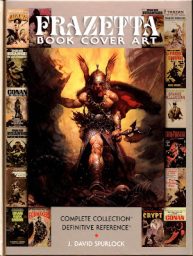 Vanguard Productions, a firm dedicated to classic illustration and graphic art, with an emphasis on comics and cartooning. ‘Frazetta Book Cover Art’ is one of a number of Vanguard books about Frazetta’s art. These books come in hardcover deluxe editions with slipcases and additional content, along with less expensive hardcover editions (which is what I purchased).
Vanguard Productions, a firm dedicated to classic illustration and graphic art, with an emphasis on comics and cartooning. ‘Frazetta Book Cover Art’ is one of a number of Vanguard books about Frazetta’s art. These books come in hardcover deluxe editions with slipcases and additional content, along with less expensive hardcover editions (which is what I purchased).
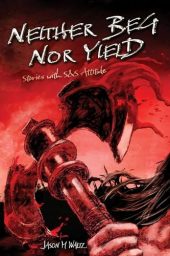 Review (DMR Books): The genesis of this epic collection began with the desire of Jason Waltz to devote more time to his writing. You see, as a publisher he was spending copious amounts of time reading, editing and publishing other author’s stories, leaving little time to his own craft. Emulating the spirit of sword & sorcery, Jason wasn’t going to go gently into that good night.
Review (DMR Books): The genesis of this epic collection began with the desire of Jason Waltz to devote more time to his writing. You see, as a publisher he was spending copious amounts of time reading, editing and publishing other author’s stories, leaving little time to his own craft. Emulating the spirit of sword & sorcery, Jason wasn’t going to go gently into that good night.
Please give us your valuable comment